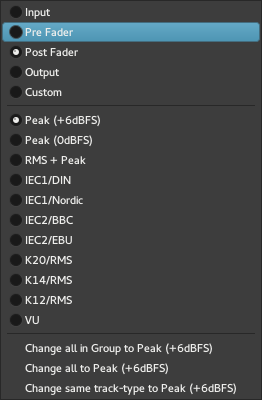Metering in Ardour
Introduction
An engineer reading and using audio level meters compares to a musician reading or writing sheet-music. Just like there are virtuoso musicians who can't read a single note, there are great sound-engineers who just go by their ears and produce great mixes and masters without ever looking at a single meter.
Yet, in order to work in or with the broadcast industry, it is usually unavoidable to use meters.
Audio level meters are very powerful tools that are useful in every part of the entire production chain:
- When tracking, meters are used to ensure that the input signal does not overload and maintains reasonable headroom.
- Meters offer a quick visual indication of an activity when working with a large number of tracks.
- During mixing, meters provide an rough estimate of the loudness of each track.
- At the mastering stage, meters are used to check compliance with upstream level and loudness standards and to optimize the loudness range for a given medium.
Meter Types
A general treatise on metering is beyond the scope of this manual. It is a complex subject with a history… For background information and further reading we recommend:
- How To Make Better Recordings in the 21st Century—An Integrated Approach to Metering, Monitoring, and Leveling Practices by Bob Katz. Has a good historic overview of meters and motivates the K-meter
- Wikipedia: Peak programme meter—overview of meter types.
- "Audio Metering: Measurements, Standards and Practice: Measurements, Standards and Practice", by Eddy Brixen. ISBN: 0240814673
- "Art of Digital Audio", by John Watkinson. ISBN: 0240515870
There are different metering standards, most of which are available in Ardour. In short:
| Digital peak-meter | A Digital Peak Meter displays the absolute maximum signal
of the raw audio PCM signal (for a given time). It is commonly used when
tracking to make sure the recorded audio never clips. To that end, DPMs
are always calibrated to 0 dBFS, or the maximum level that can be represented digitally
in a given system. This value has no musical reason whatsoever and depends
only on the properties of the signal chain or target medium. There are
conventions for fall-off-time and peak-hold, but no
exact specifications.
Various conventions for DPM fall-off times and dBFS line-up level can be chosen in Edit > Preferences > Metering. |
|---|---|
| RMS meters | An RMS-type meter
is an averaging meter that looks at the energy in the signal. It
provides a general indication of loudness as perceived by humans. Ardour
features three RMS meters, all of which offer additional peak indication.
|
| IEC PPMs | IEC-type
PPMs are a mix between DPMs and
RMS meters, created mainly for the purpose of
interoperability. Many national and institutional varieties exist (EBU, BBC, DIN).
These loudness and metering standards provide a common point of reference which is used by broadcasters in particular so that the interchange of material is uniform across their sphere of influence, regardless of the equipment used to play it back. For home recording, there is no real need for this level of interoperability, and these meters are only strictly required when working in or with the broadcast industry. However, IEC-type meters have certain characteristics (rise-time, ballistics) that make them useful outside the context of broadcast. Their specification is very exact, and consequently, there are no customizable parameters. |
| VU meters | VU meters are the dinosaurs (1939) amongst the meters. They react very slowly, averaging out peaks. Their specification is very strict (300ms rise-time, 1–1.5% overshoot, flat frequency response). Ardour's VU meter adheres to that spec, but for visual consistency it is displayed as a bar-graph rather than needle-style (more below). |
Ardour Specifics

Meters are available in various places in Ardour:
- The mixer window features fixed height meters for each channel strip.
- There are small (narrow) meters on each track-header in the editor window.
- There are variable height meters in the meterbridge window.
- Optionally, a fixed-size master meter can be displayed in the main toolbar.
- Various other locations (file import, sends) have level-meters.
They all share the same configuration and color-theme which is available in preferences and the theme-manager. Settings for the Peak and RMS+Peak meters as well as VU meter standards are found in Edit > Preferences > Metering.
The type of meter and the metering point (the place in the signal chain where the meter taps the signal) are configurable in the context menu of each meter. Depending on the Edit > Preferences > Mixer settings, the metering point is also accessible via a button in each Mixer strip.
Regardless of meter type and standard the meter display will highlight red if the signal on the given channel exceeds the configured peak threshold.
Left clicking on the peak-indicator button resets the
peak-hold indicator of a single channel.
Left clicking resets a whole group, and
Left clicking resets all meters.
Overview of meter types


The figure on the left shows all available meter-types in Ardour when fed with a -18 dBFS 1 kHz sine wave.
Due to layout concerns and consistent look and feel all meters available in Ardour itself are bar-graph type meters. Corresponding needle-style meters—which take up more visual screen space—are available as LV2 plugins (see image on the right): meters.lv2.
